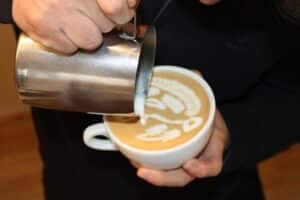[[{“value”:”
The Australian Latte Art Champion and BeanScene Espresso Yourself columnist Victor Vu connects coffee and nature with his jungle inspired design.
It’s been four years since I first won the ASCA Australian Latte Art Championship, and I was thrilled to win again in 2024 and go on to compete on the world stage for a second time.
For this edition, I chose to highlight my rhino, one of the designs I shared at this year’s national championship. This year I wanted to upgrade my latte art to a higher level to impress the judges. After a two-year hiatus from competing, at first I struggled to get into the right headspace in the lead up to the competition. It took resilience, and positivity to get through it. These are themes I chose to take to the national stage.
To me, a rhino represents strength, bravery, and power; three things I will need when representing Australia at the Worlds from 27 to 29 June in Copenhagen, Denmark.
This is an advanced latte art pattern and not something you’re likely to get on the first try. The pattern involves rosettas and milk dragging, and requires a steady hand to execute correctly.
Typically, the details of the face would involve etching, but I use the weight of the milk to create it with free pour. Although etching is a great way to add detail, I wanted to test my skills without it, and showcase that it can be done freehand.
You also need an understanding of how certain movements, strokes, and swirls will impact the rest of your design. I use sharp angles for the rhino’s mouth and eye to create the fierce anger of the animal.
Like the powerful rhino, keep working on this design until you can achieve your goal.
This article appears in the June 2024 edition of BeanScene. Subscribe HERE.
Step 1
Starting with the handle at three o-clock, pour a 12-leaf rosetta on the left side of the cup from the 10 o-clock position downwards.
Step 2
Draw a smaller six-leaf rosetta directly next to it, forming the rhino’s cheek.
Step 3
Turning the cup slightly towards you to five o-clock, pour another six-leaf rosetta directly across the cup, starting from the handle side. Then pour two four-leaf rosettas in the top middle of the cup to create the leaves on a tree branch.
Step 4
Keep the cup in the same position. Use the milk weight to connect the two branches, dragging the milk towards you.
Step 5
To create the rhino’s face, start your pour a little higher than the first rosetta in the centre of the cup. In one continuous motion, drag the milk down the cup to create the curve of the forehead, a small loop for the nostril, and the mouth and chin, finishing at the bottom of the first rosetta.
Step 6
Aim your pitcher above the third rosetta and drag the milk across the cup, in line with the third rosetta. Sharply drag the milk upwards to create a pointed tip, in line with the second rosetta. Connect the two lines together in a triangle shape to form the eye.
Step 7
For the ear, position your pitcher above the first rosetta. Create another triangle-like shape and connect the forehead to the first rosetta.
Step 8
Finish by dragging your pour to create two horns. Starting with the smaller horn above the eye, then the longer horn on top of the rhino’s nose.
“}]]


